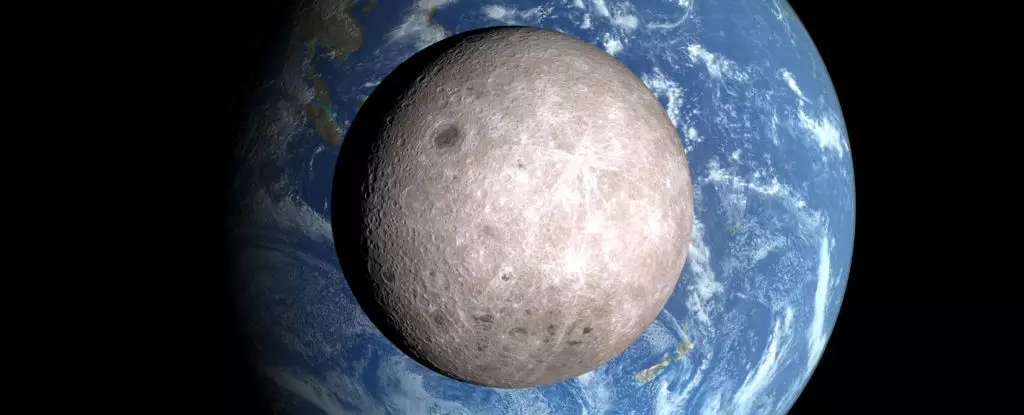The Moon has long captivated humanity’s imagination, but a recent revelation about its water distribution has sparked both intrigue and concern among scientists. Analysis of lunar materials gathered from the Moon’s far side indicates a distinct lack of water compared to its Earth-facing counterpart. This disparity isn’t merely a trivial finding; it poses profound questions about the Moon’s history and evolution. The Moon’s far side, dominated by heavy craters, starkly contrasts with the more hospitable, basaltic plains of the near side. Here, we stand at the precipice of understanding the Moon’s developmental past, but the puzzle remains incomplete.
The pronounced differences in surface composition between the two hemispheres provoke a variety of theories. Why does the far side appear so desolate? Is this a mere coincidence, or does it reveal something deeper about the Moon’s formation and the forces that shaped it? As researchers led by Huicun He and Linxi Li from the Chinese Academy of Sciences propose, the water content in the Moon’s mantle may hold critical keys to the Moon’s origin, specifically the hypothesis involving a cataclysmic collision with a Mars-sized planetesimal, dubbed ‘Theia.’
Water: The Essential Element
Water is more than just a substance; it is a vital player in shaping geological processes. It plays an essential role in volcanic activity and crystallization, forming the very dawn of the Moon as we know it. The new estimates regarding water abundance in the lunar mantle serve not only to enrich our understanding but also to challenge the existing notions regarding how our natural satellite came into existence. The lunar debris, resulting from the ancient impact, offers a semblance of Earth’s early characteristics—yet remarkably, the opposite sides of the Moon tell very different stories.
The unearthing of these findings from the Chang’e-6 mission is pivotal for confirming hypotheses about the Moon’s uneven chemical makeup. Historically, evidence has suggested a gradient of water presence on the Moon, with concentrations varying significantly. It raises an uncomfortable thought: If some areas are relatively barren in resources, what does that imply for future exploration and potential colonization efforts?
A Collision Course of Ideas
The prevailing theory regarding the Moon’s origin—a massive collision in the Solar System’s infancy—has long fascinated astronomers and planetary scientists alike. Emerging evidence suggesting that the far side may lack crucial resources like water draws us into a complex web of implications about that colossal impact. Would the force of such a collision have pushed essential elements to the near side? This eventuality would radically alter our understanding of the Moon’s formative processes and possibly even its utility for future missions.
Could this uneven distribution be indicative of deliberate cosmic forces at play? The potential for fear arises as we probe deeper into these celestial mechanisms. If the far side truly is a wasteland in comparison, might our lunar explorations be severely limited? There’s a great tension between the dream of reaching and sustaining human life on the Moon and the realities of its geological makeup.
The Far Side Turned Towards the Unknown
China’s Chang’e-6 mission has provided a glimpse into the potential character of the far Moon, taking samples that reveal significantly lower water content compared to their near side counterparts. Is this imbalance merely a fluke, or does it signify a broader pattern? The investigation at the South Pole-Aitken Basin could open a Pandora’s box of revelations about the Moon’s primordial nature, yet it leaves us yearning for more samples to support or challenge the inferences presented.
The initial findings may suggest that while the far side remains arid, it’s critical to remember that these results stem from a single sample. This may portray a rather skewed picture of the Moon’s characteristics. However, the potential for discovery remains tantalizing; unearthing new samples may reveal more about the true nature of the lunar crust and what lay hidden beneath.
Ultimately, this imbalance of resources isn’t just a challenge; it embodies the dual essence of exploration—of ambition and uncertainty. Humanity’s quest to understand the Moon and its resources embodies a balance between the hope for discovery and the heavy weight of reality. As we gaze up at that luminous orb overshadowed by our planet, the Moon retains its mystique. Will it remain a tantalizing enigma, or will we dare to unravel its watery secrets?


Leave a Reply